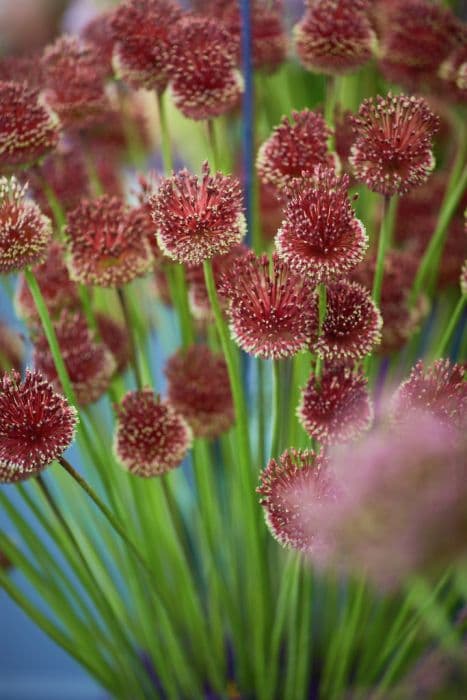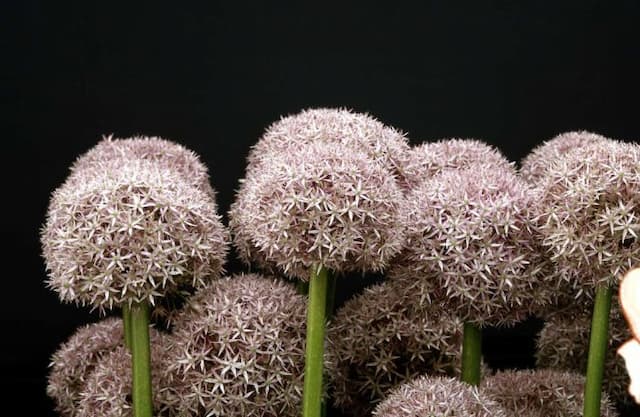Keeled garlic Allium carinatum subsp. pulchellum f. album

ABOUT
The plant in question, commonly known as Keeled Garlic, exhibits a distinctive appearance characterized by its striking flowers. Its flowers are pure white, which form a star-like shape, giving it a delicate and elegant look. These blooms cluster together in an umbrella-shaped head, sitting atop a single, sturdy stem that rises above the foliage. The leaves of the Keeled Garlic are narrow and elongated, presenting a mid-green hue which provides a subtle backdrop for the dramatic flowers. Each individual flower boasts a set of six petals with a slight curve, imparting a sense of depth and texture to the flower heads. The plant's overall appearance could be described as airy and graceful, with the white flowers catching the eye against the contrasting green of the leaves.
About this plant
 Names
NamesFamily
Amaryllidaceae
Synonyms
Ornamental Garlic, Keeled Garlic, White Keeled Garlic
Common names
Allium carinatum var. pulchellum, Allium pulchellum.
 Toxicity
ToxicityTo humans
Kornig garlic (Allium carinatum) is typically not toxic to humans when consumed in normal food quantities. Being a member of the onion family, it is generally safe for most individuals; however, overconsumption of garlic and its relatives can lead to gastrointestinal discomfort or irritation. In rare cases and with excessive consumption, it could result in symptoms such as nausea, vomiting, or diarrhea. People with a known allergy or hypersensitivity to Allium species may experience allergic reactions upon ingestion of kornig garlic. It is important to consume such plants in moderation and with caution if there is a known sensitivity.
To pets
Kornig garlic (Allium carinatum) is considered toxic to cats and dogs, and potentially to other pets as well. All Allium species, including onions, garlic, leeks, and chives, contain compounds that can cause oxidative damage to red blood cells leading to hemolytic anemia if ingested in significant amounts by pets. The symptoms of poisoning can include lethargy, pale gums, rapid breathing, weakness, jaundice, vomiting, diarrhea, and sometimes reddish urine. The severity of symptoms can be influenced by the amount ingested and the size of the pet. Pet owners should take caution to ensure pets do not have access to such plants and should seek veterinary assistance immediately if they suspect their pet has ingested any part of the plant.
 Characteristics
CharacteristicsLife cycle
Perennials
Foliage type
Deciduous
Color of leaves
Green
Flower color
White
Height
2 feet (60 cm)
Spread
1 foot (30 cm)
Plant type
Bulb
Hardiness zones
4
Native area
Europe
Benefits
 General Benefits
General Benefits- Ornamental Appeal: Allium carinatum subsp. pulchellum f. album, commonly known as Keeled Garlic, features attractive blooms which can enhance garden aesthetics.
- Pollinator Attraction: The flowers of the Keeled Garlic are known to attract bees and other pollinators, supporting local ecosystems.
- Low Maintenance: Keeled Garlic tends to require minimal care once established, making it a hassle-free choice for gardeners.
- Drought Resistance: Adaptable to various conditions, this plant can survive periods of low water, reducing the need for frequent irrigation.
- Culinary Uses: The edible parts of Keeled Garlic can be used in cooking, offering a mild garlic flavor to dishes.
- Companion Planting: It can be planted alongside other species to assist in natural pest control, through its scent or other mechanisms.
 Medical Properties
Medical PropertiesThis plant is not used for medical purposes.
 Air-purifying Qualities
Air-purifying QualitiesThis plant is not specifically known for air purifying qualities.
 Other Uses
Other Uses- Allium carinatum subsp. pulchellum f. album, commonly known as the "Keeled garlic," can be utilized in floral arrangements, especially in wildflower or cottage-style bouquets, to add a unique, ornamental touch.
- The dried flower heads of Keeled garlic can be used in crafts, such as wreath making, due to their intricate and appealing shape.
- This plant can serve as a natural dye source, providing colors ranging from pink to purple when used to dye fabrics or yarn.
- The seed heads of Keeled garlic can be interesting additions to dried flower compositions, contributing texture and visual interest.
- Keeled garlic's tall flowering stems can act as natural stakes in the garden, supporting and adding vertical interest among lower growing plants.
- The plant can also attract and support beneficial insects in the garden, such as pollinators, aiding in the overall health of the garden ecosystem.
- By planting Keeled garlic, gardeners can contribute to biodiversity, as it helps provide habitat and food for a variety of wildlife, including birds who feed on the seeds.
- Keeled garlic can be used in natural pest control, as alliums are believed to help deter certain insects and animals when interplanted with vegetables and fruits.
- In culinary arts, the flowers can be used as an edible garnish for salads and other dishes, adding a mild garlic flavor and a decorative element.
- The resilient qualities of Keeled garlic make it suitable for xeriscaping, a landscaping method aimed at reducing the need for irrigation through the use of drought-tolerant plants.
Interesting Facts
 Feng Shui
Feng ShuiThe Ornamental Onion is not used in Feng Shui practice.
 Plant Symbolism
Plant Symbolism- Prosperity: Alliums in general are often associated with abundance and prosperity due to their full, round heads which can mirror the idea of fullness and wealth.
- Unity: The spherical shape of the Allium's flower head also symbolizes unity, with the many small flowers making up the whole, reflecting the concept of togetherness and solidarity.
- Patience: Given that Alliums (like Allium carinatum subsp. pulchellum f. album) take time to grow and bloom, they can represent patience and the idea of waiting for something beautiful to unfold.
- Humility: As a member of the onion family, which is a humble and essential ingredient in many cuisines, Alliums can symbolize humility and the importance of grounding and foundational qualities in character.
- Good Fortune: In some cultures, Alliums are thought to bring luck, so they may be used in ceremonies or occasions that wish good fortune upon someone.
- Strength and Courage: The sturdy stems and robust nature of Alliums, which allow them to stand upright and bloom boldly, can symbolize strength and the courage to stand firm.
 Water
WaterFor the Ornamental Onion, during the growing season, it should be watered thoroughly whenever the top inch of soil feels dry. This is typically once a week, but may increase to twice a week during very hot or dry periods. Provide about one gallon of water per square yard of soil each time you water to ensure deep soil moisture, which encourages strong root growth. In winter or during the plant's dormancy period, reduce watering significantly to prevent bulb rot.
 Light
LightThe Ornamental Onion thrives in full sunlight. The best location to plant is a spot where it can receive at least six hours of direct sunlight per day, although it can tolerate partial shade. Avoid placing it in deeply shaded areas, as this can affect the vibrancy of its blooms and overall health.
 Temperature
TemperatureOrnamental Onion prefers moderate temperatures and will grow best when daytime temperatures are between 55°F and 75°F. It can withstand temperatures as low as 20°F and as high as 90°F, but prolonged exposure to extremes can be harmful. Ideally, maintain a consistent temperature within the preferred range to ensure healthy growth.
 Pruning
PruningPruning of the Ornamental Onion isn't strictly necessary, but deadheading spent flowers can encourage more blooms and prevent self-seeding if not desired. The best time to prune is after flowering, typically in the late summer. Cut back foliage only after it has yellowed and died down naturally to allow energy to return to the bulb for next year's growth.
 Cleaning
CleaningAs needed
 Soil
SoilThe Kiel Garlic requires a well-drained soil mix with a pH of around 6.0-7.5. A combination of loamy soil, sand, and compost provides good drainage and nutrient content suitable for this plant.
 Repotting
RepottingThe Kiel Garlic needs to be repotted every 2-3 years or when it outgrows its current pot to promote healthy growth and prevent overcrowding of bulbs.
 Humidity & Misting
Humidity & MistingKiel Garlic prefers average to low humidity levels and does not require any special humidity adjustments when grown in typical outdoor conditions.
 Suitable locations
Suitable locationsIndoor
Provide bright light and good air circulation for indoor Kiel Garlic.
Outdoor
Plant in well-drained soil; full sun; shelter from strong winds for Kiel Garlic.
Hardiness zone
4-8 USDA
 Life cycle
Life cycleAllium carinatum subsp. pulchellum f. album, commonly known as Keeled Garlic, begins its life cycle as a seed, which will germinate in favorable conditions such as cool soil and adequate moisture. Upon germination, roots establish and a shoot emerges, developing into a slender stem with linear leaves in its juvenile growth stage. As the plant matures, it undergoes vegetative growth, forming a bulb from which new shoots may sprout in subsequent years. Keeled Garlic enters a reproductive stage in the summer months, producing distinctive, rounded clusters of star-shaped, white flowers atop a tall stem. After flowering, seeds are formed and dispersed, and the plant's above-ground growth dies back, with the bulb entering a period of dormancy during the colder months. The lifecycle can repeat when conditions become favorable again, with new growth emerging from the bulb or germinating seeds in the following growing season.
 Propogation
PropogationPropogation time
Spring to early summer
Propogation: The most popular method of propagating Allium carinatum subsp. pulchellum f. album, commonly known as Knapweed garlic, is through seed sowing. Seed should be sown in fall, allowing the winter cold to stratify the seeds, which enhances germination in spring. Alternatively, you can sow seeds in a cold frame or an unheated greenhouse during the winter. It is crucial to use well-draining soil and to cover the seeds lightly with soil. Keep the soil moist but not waterlogged until germination occurs, which can take several weeks to a few months depending on conditions. Once seedlings have developed true leaves and are large enough to handle, they can be transplanted into their final location in the garden. It's important to give the plants enough space for growth, generally a gap of about 4 to 6 inches (approximately 10 to 15 centimeters) between each plant.









